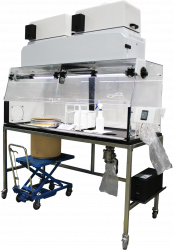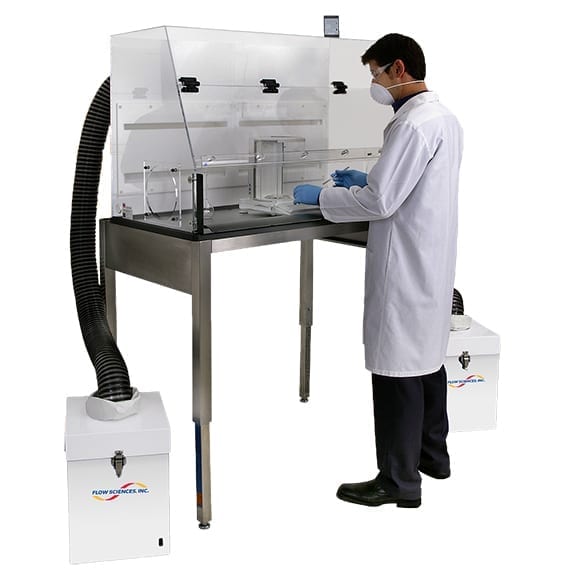
Laboratory enclosures and biological safety cabinets are crucial for maintaining a safe and sterile environment in research and healthcare facilities. These specialized pieces of equipment provide protection for both laboratory workers and the materials they handle from potential contamination, hazardous chemicals, and biological agents. Biological safety cabinets, in particular, are designed to prevent the release of infectious particles or organisms into the environment, making them essential for research and clinical applications involving potentially harmful materials. The category page of Laboratory Enclosures and Biological Safety Cabinets provides information on different types of enclosures and cabinets available in the market, their features, and their applications in different industries.



Home » Ventilation and Critical Space Testing » Laboratory Enclosures and Biological Safety Cabinets
There are three primary types of biological safety cabinets (BSCs) available in the market, and they are classified based on their airflow patterns. These types include:
Class I: These BSCs are designed for personnel and environmental protection. They draw in contaminated air through the front opening and exhaust it through a HEPA filter. Class I cabinets do not provide product protection.
Class II: Class II BSCs are further divided into four subcategories, namely A1, A2, B1, and B2. They provide both personnel and product protection and are the most commonly used type of BSC. These cabinets draw in air through the front opening, and it passes through HEPA filters to remove contaminants. The exhaust air is either recirculated or released into the atmosphere.
Class III: These BSCs provide the highest level of protection for both personnel and the environment. Class III cabinets are gas-tight enclosures that use glove ports for handling materials. They provide maximum protection against hazardous biological agents and require a separate air supply and exhaust system.
Some of the features of biological safety cabinets include automatic controls for monitoring and maintaining the airflow, alarms to alert the user in case of malfunctions, and built-in UV lamps to sterilize the cabinet between uses. Other features include adjustable height work surfaces, low noise levels, and easy-to-use digital controls.
Choosing the appropriate laboratory enclosure or biological safety cabinet (BSC) for your research or clinical application requires careful consideration of several factors, including the type of material being handled, the level of protection needed, the size of the workspace, and the type of research being conducted. Additionally, it is important to consider the certification requirements, such as NSF International standards, and the local regulations and guidelines that may apply. It is also important to consider the availability of maintenance and repair services. Consulting with a laboratory equipment supplier or a biosafety expert can help ensure that the appropriate BSC or laboratory enclosure is selected for the specific application.
Biological safety cabinets (BSCs) require regular maintenance to ensure their continued safe and effective operation. Regular maintenance activities include cleaning and decontamination of the interior surfaces, replacement of HEPA filters, and periodic testing of the cabinet’s performance. The frequency of these activities may vary depending on the usage level and the type of material being handled. Typically, HEPA filters should be replaced at least once a year, or more frequently if the cabinet is used heavily or with hazardous materials. The cabinet’s performance should be tested annually, and additional testing may be required after major repairs or filter changes. It is important to follow the manufacturer’s guidelines and certification standards, such as NSF International standards, for maintenance and testing procedures. Additionally, it is recommended to have a certified technician perform any necessary repairs or maintenance activities.
There are various regulations and standards governing the use of laboratory enclosures and biological safety cabinets in different industries. These regulations and standards aim to ensure the safety of the workers and the environment, as well as the efficacy of the research or clinical application.
In the United States, the Occupational Safety and Health Administration (OSHA) sets standards for laboratory safety, including the use of biological safety cabinets. OSHA’s standard on Occupational Exposure to Hazardous Chemicals in Laboratories requires that biological safety cabinets meet the NSF/ANSI Standard 49, which outlines the performance and design criteria for BSCs.
In the pharmaceutical industry, the US Food and Drug Administration (FDA) sets regulations for the manufacture and use of pharmaceutical products. The FDA requires that biological safety cabinets used in pharmaceutical manufacturing meet the NSF/ANSI Standard 49, as well as the current Good Manufacturing Practice (cGMP) regulations.
In the healthcare industry, the Centers for Disease Control and Prevention (CDC) provides guidelines for the use of BSCs in healthcare settings. The CDC’s guidelines for infection prevention and control in healthcare facilities recommend the use of Class II BSCs for handling infectious materials.
Internationally, the World Health Organization (WHO) provides guidelines for the use of BSCs in handling infectious agents. The WHO’s laboratory biosafety manual outlines the design, installation, and maintenance requirements for BSCs used in different biosafety levels.
It is important to consult the relevant regulations and standards for your specific industry and application to ensure compliance and safety.
To properly clean and decontaminate a biological safety cabinet, the following steps should be taken:
It’s important to wear personal protective equipment (PPE) when cleaning a biological safety cabinet, including gloves, a lab coat, and eye protection. Additionally, follow all applicable regulations and guidelines, and refer to the manufacturer’s instructions for specific cleaning and decontamination procedures.
Tel +1 561-912-9809 / 561-9112-7201
E-mail [email protected]
6590 W Rogers Circle Suite# 11&12
Boca Raton – FL 33487
+1 561-912-9809 / +1 561-912-7201
[email protected]
6590 W Rogers Circle, Suite #11&12
Boca Raton, FL 33487